Time lines for tenses

Here are some ideas for how to represent the concepts of English
tenses with time lines.
There are some things to note before you rush to use them:
- Represented here are some usual uses of the tense forms. Many tense forms can be used for more than one concept. See the guides to tense, time and aspect for more on that.
- There are two kinds of tense represented here:
- Absolute tenses which can be understood without reference to
any other tense or time such as:
She left
They will go
She is sitting on the train - Relative or relational tenses which can only be understood with reference
to another time such as:
She has arrived so we can start
which can only be understood by seeing the past from the present. In other words, it sets the past within the present.
They will have left before you get here
which can only be understood be seeing one future event looking back from the point of view of another. In other words, it sets the past in the future.
She is taking the train tomorrow
which can only be understood as looking forward from a present arrangement to a future event. In other words, it sets the future within the present.
In the time lines below, all relational tense forms have this symbol (sometimes reversed) included in them:
 or
or

and it represents the viewpoint of the speaker.
Not including this representation makes nonsense of the time lines.
- Absolute tenses which can be understood without reference to
any other tense or time such as:
| Time line | Tense name | Note |
Absolute tenses |
||
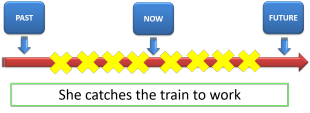 |
Present simple | This is a timeless tense insofar as
it usually refers to a current habit or repeated behaviour. It does not usually refer to what is happening right now (so there is no yellow cross in that position). |
 |
Present progressive | This has two meanings (there's
another below) but this time line simply shows what is
happening at the time of speaking. It refers to something ongoing or a continuous state in the background. It is important that no beginning and end are emphasised. |
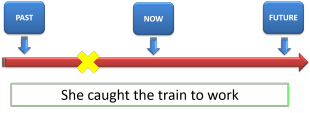 |
Past simple | This is an absolute tense referring
to a completed action before now. It does not need to be understood by reference to any other time. |
 |
Past progressive | Sometimes this tense just refers to
a progressive event in the past with no reference to
anything else. However, this timeline is intended to show that event 1 is was the sitting on the train and it was interrupted by event 2. Sometimes event 2 means that event 1 stops immediately. At other times, event 1 may continue after the interruption (as here). We do not need the eye here because it's an absolute form usually but it helps some learners. The time line used here works well for sentences such as: She was sitting on the train when I called her because my calling did not stop her sitting on the train. |
 |
Past simple | The reason we have three examples
here is to show that the simple past can also be used to
refer to durative events in the past. This is a semantic issue, not a grammatical one per se because only verbs which are themselves descriptive of long-duration events work in this way. |
 |
Past progressive | In this case,
the interruption to event 1 means that it stopped at that
point rather than continuing as in the previous example. Rather obviously, the cycling did not continue after the accident. Compare that to a sentence such as: She was cycling when she had the idea which would be represented by the previous time line. |
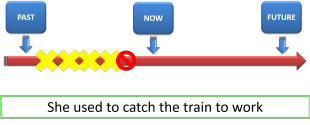 |
used to | This refers to the past but the form
signals that a repeated event is not longer happening. It is a discontinued habit or a repeated event which no longer occurs. That is the significance of the red symbol. |
 |
used to | In this case we are also referring
to a past state but there is no sense of a repeated habit. The sense is that a state of affairs has finished and the person in question is no longer rich. |
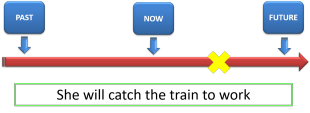 |
Future simple or will future | This is generally used to refer to
an event the speaker is certain occurs in the future. It needs no other time reference to be understood. |
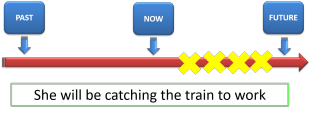 |
Future progressive | This is similar to the last example
but usually refers to a future action that will be repeated. In the technical term, that is an iterative aspect. It often refers to a temporary future habit so the sentence example could go on: ... until her car is repaired. |
 |
This is the same tense form with a
different meaning. Here the concept is akin to: She was sitting on the train to work ... ... when she was interrupted / had an idea ... etc. but in this case the event is projected into the future and is only potentially interruptible so the sentence could be completed with: ... so you can't call; she always switches her phone off on the train. |
|
Relative /relational tenses |
||
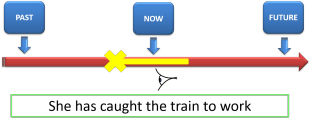 |
Present perfect | This tense sets a past action in the
terms of the present. Often this is called the present-relevance phenomenon because the past action changes the present so the sentence could be completed with: ... so try her mobile number. because she is no longer here. |
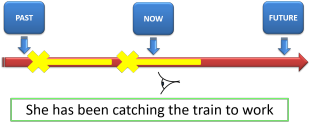 |
Present perfect progressive | This is similar to the last example
and refers to an action which can only be understood with
reference to the present situation. However, in this case, the action in the past which affects the present (or is embedded in it) is repeated. It often refers to a temporary habit so the sentence example could go on: ... because her car is off the road. |
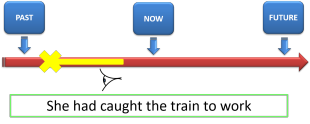 |
Past perfect | Here we have one past event or
action embedded in another. The eye looks back from the past to the pre-past. The situation where the eye is has been altered by the event that occurred before then so the sentence could be finished with: ... so I had to call her on her mobile. |
 |
Past perfect progressive | This is similar to the last example
and refers to an action which can only be understood with
reference to the past situation. However, in this case, the action before the past which affected the past (or is embedded in it) is repeated. It often refers to a temporary habit so the sentence example could go on: ... because her car was off the road. |
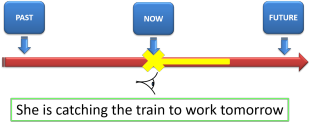 |
Present progressive for the future | This is a relational tense because it
does not refer to the future or the present. It refers
to the present with a prospective (i.e., future) aspect. It is often a signal that something is arranged so the sentence could be completed with: ... because the car is being serviced. |
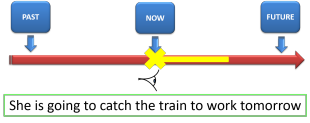 |
going to future | This has the same timeline as the
example above because it is often interchangeable with the present progressive for the future. The difference, if there is any, here is that in the first, an arrangement is made where the yellow cross is and in the second an intention has been formed. The tense form is often used to speak about present evidence as in: It's going to rain; look at the sky |
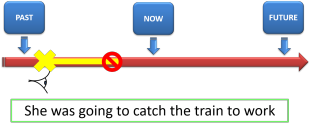 |
Future in the past | The tense form is usually used to
speak about an intention formed in the past which was
frustrated in some way and did not result in an action.
That's the significance of the red symbol. The sentence could be completed with: ... but, unfortunately, there was a strike. or ... but her mother offered to drive her. A very similar time line can be drawn for a sentence such as She was to give a presentation but the meeting was cancelled. |
 |
Past progressive for future in the past | This is a reference to a past arrangement which was (probably) fulfilled. Both the arrangement and the prospective event are set in the past. |
 |
Future in the past | This tense form is frequently used
to speak about predictions or assumptions made in the past. Event 1, the prediction, precedes event 2 (becoming famous) but both are set in the past, although, as the line shows, the fact of being famous may be current and extend into a assumed future. |
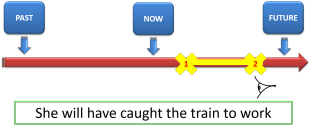 |
Future perfect | Here we have two future events
understandable only in relation to each other. We are looking back from the second event to see the completion of the first. It is the past embedded in the future. The tense refers to event 1 in relation to a later event (2). |
 |
Future perfect progressive | Here we have the same scenario but
of repeated events in the future. This is quite a rare tense form because it describes an unusual circumstance. |
 |
could vs. was able to | This time line demonstrates that
either could or was able to can be used
for long-lasting abilities in the past, viewed from the
present but it also shows that the situation may no longer
be the case, hence the ? It should be used in conjunction with the next diagram. |
 |
was able to | This, on the other hand,
demonstrates that only was able to is normally used
to refer to a single, one-off event concerning ability in
the past. It should be used in conjunction with the previous diagram. |
 |
must have and might / could have | These two diagrams show
the distinction between an event perceived as almost certain
and one which is speculative. There is no eye in these diagrams because neither is a relational tense form and learners should not be led to believe that this use is akin to a present perfect form. Both uses of the modal auxiliary verbs are absolute past tense forms. |
 |
||
As you can see, tense forms and the concepts they encode are not
a simple matter in English and most languages do not have parallel
forms or parallel concepts.
That's why time lines may help but they need to be backed up with
clear contexts in which to set the forms.
There is a guide in the learners section of this site which uses
time lines with explanations to help learners understand a complex
and unfamiliar system.
Click here to go there (new tab).
 |
Building time lines |
Whether you have prepared an attractive time line beforehand or are using one in response to an emerging need, you need to carry the learners with you as you go. It is much better to build up the time line, explaining each part as you go, than to present your learners with the finished article and get them to try to work out what it all means.
If you would like to see an example of how to build a time line step-by-step on the board, see the guide to using timelines (new tab).
Here is an index of other guides to tense forms:
| The map of English tenses | This is a diagram of all the English
tense forms. Clicking on parts of it will take you to
guides to the individual tense forms of
English. The page also contains examples of all the forms with their main uses. |
| Time, tense and aspect | There is an introduction to some key
terms and 4 dedicated guides linked from it in this section. The guides are slightly more advanced because they consider a range of aspects (not only progressive, continuous and perfect). |
| The initial-plus section | This takes you to the initial-plus
index to verbs which contains links to simpler guides. From there you can navigate to the area which interests you (mostly essential guides to key areas). |
| The in-service section | This takes you to the
in-service index to verbs for more technical guides to verbs and tenses. From there you can navigate to the area which interests you (aspect, mood, subjunctives etc.). |
| The A-Z index | As an alternative, use this index to
find what you need. All tenses and much else are indexed there. |
